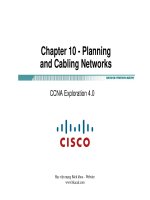ccna explorationg 4.0 - chapter 6 teleworker services
Bạn đang xem bản rút gọn của tài liệu. Xem và tải ngay bản đầy đủ của tài liệu tại đây (2.04 MB, 53 trang )
1
Chapter 6 - Teleworker Services
CCNA Exploration 4.0
Học viện mạng Bach Khoa - Website: www.bkacad.com 2
Introduction
Học viện mạng Bach Khoa - Website: www.bkacad.com 3
Business Requirements for
Teleworker Services
Học viện mạng Bach Khoa - Website: www.bkacad.com 4
The Business Requirements for Teleworker Services
• When designing network architectures that support a teleworking
solution, designers must balance organizational requirements for
security, infrastructure management, scalability, and affordability
against the practical needs of teleworkers for ease of use, connection
speeds, and reliability of service.
Học viện mạng Bach Khoa - Website: www.bkacad.com 5
The Teleworker Solution
• The term broadband refers to advanced communications systems capable of
providing high-speed transmission of services, such as data, voice, and video,
over the Internet and other networks.
• Transmission is provided by a wide range of technologies, including digital
subscriber line (DSL) and fiber-optic cable, coaxial cable, wireless technology,
and satellite.
Học viện mạng Bach Khoa - Website: www.bkacad.com 6
• Soon, voice over IP (VoIP) and videoconferencing components will become expected
parts of the teleworkers toolkit.
• Home Office Components - The required home office components are a laptop or
desktop computer, broadband access (cable or DSL), and a VPN router or VPN client
software installed on the computer. Additional components might include a wireless
access point. When traveling, teleworkers need an Internet connection and a VPN client
to connect to the corporate network over any available dialup, network, or broadband
connection.
• Corporate Components - Corporate components are VPN-capable routers, VPN
concentrators, multifunction security appliances, authentication, and central
management devices for resilient aggregation and termination of the VPN connections.
The Teleworker Solution
Học viện mạng Bach Khoa - Website: www.bkacad.com 7
Broadband Services
Học viện mạng Bach Khoa - Website: www.bkacad.com 8
Connecting Teleworkers to the WAN
• The choice of access
network technology and
the need to ensure
suitable bandwidth are
the first considerations
to address when
connecting teleworkers.
Học viện mạng Bach Khoa - Website: www.bkacad.com 9
Connecting Teleworkers to the WAN
Học viện mạng Bach Khoa - Website: www.bkacad.com 10
Cable
Học viện mạng Bach Khoa - Website: www.bkacad.com 11
Cable
Học viện mạng Bach Khoa - Website: www.bkacad.com 12
Cable
Học viện mạng Bach Khoa - Website: www.bkacad.com 13
Cable
• The Data-over-Cable Service Interface Specification (DOCSIS) is an international
standard developed by CableLabs, a non-profit research and development consortium
for cable-related technologies.
• DOCSIS specifies the OSI Layer 1 and Layer 2 requirements:
– Physical layer - For data signals that the cable operator can use, DOCSIS specifies
the channel widths (bandwidths of each channel) as 200 kHz, 400 kHz, 800 kHz, 1.6
MHz, 3.2 MHz, and 6.4 MHz. DOCSIS also specifies modulation techniques (the
way to use the RF signal to convey digital data).
– MAC layer - Defines a deterministic access method, time-division multiple access
(TDMA) or synchronous code division multiple access method (S-CDMA).
Học viện mạng Bach Khoa - Website: www.bkacad.com 14
Cable
Học viện mạng Bach Khoa - Website: www.bkacad.com 15
Học viện mạng Bach Khoa - Website: www.bkacad.com 16
DSL
• DSL is a means of providing high-speed connections over installed copper wires.
• Several years ago, Bell Labs identified that a typical voice conversation over a local loop
only required bandwidth of 300 Hz to 3 kHz.
• Advances in technology allowed DSL to use the additional bandwidth from 3 kHz up to 1
MHz to deliver high-speed data services over ordinary copper lines.
• The two basic types of DSL technologies are asymmetric (ADSL) and symmetric (SDSL).
• The transfer rates are dependent on the actual length of the local loop, and the type and
condition of its cabling. For satisfactory service, the loop must be less than 5.5
kilometers (3.5 miles).
Học viện mạng Bach Khoa - Website: www.bkacad.com 17
DSL
• The two key components are the DSL transceiver
and the DSLAM:
– Transceiver - Connects the computer of the
teleworker to the DSL. Usually the transceiver is
a DSL modem connected to the computer using
a USB or Ethernet cable. Newer DSL
transceivers can be built into small routers with
multiple 10/100 switch ports suitable for home
office use.
– DSLAM - Located at the CO of the carrier, the
DSLAM combines individual DSL connections
from users into one high-capacity link to an ISP,
and thereby, to the Internet.
Học viện mạng Bach Khoa - Website: www.bkacad.com 18
DSL
• The major benefit of ADSL is the ability to provide data services along with
POTS voice services.
• ADSL signals distort voice transmission and are split or filtered at the customer
premises. There are two ways to separate ADSL from voice at the customer
premises: using a microfilter or using a splitter.
Học viện mạng Bach Khoa - Website: www.bkacad.com 19
DSL
• A microfilter is a passive low-pass filter with two ends. One end connects to
the telephone, and the other end connects to the telephone wall jack. This
solution eliminates the need for a technician to visit the premises and allows
the user to use any jack in the house for voice or ADSL service.
Học viện mạng Bach Khoa - Website: www.bkacad.com 20
DSL
• POTS splitters separate the DSL traffic from the POTS traffic. The POTS
splitter is a passive device. In the event of a power failure, the voice traffic still
travels to the voice switch in the CO of the carrier.
• Splitters are located at the CO and, in some deployments, at the customer
premises. At the CO, the POTS splitter separates the voice traffic, destined for
POTS connections, and the data traffic destined for the DSLAM.
Học viện mạng Bach Khoa - Website: www.bkacad.com 21
Broadband Wireless
• Broadband access by ADSL or cable provides teleworkers with faster connections than
dialup, but until recently, SOHO PCs had to connect to a modem or a router over a Cat 5
(Ethernet) cable.
• Wireless networking, or Wi-Fi (wireless fidelity), has improved that situation, not only in
the SOHO, but on enterprise campuses as well.
• The benefits of Wi-Fi extend beyond not having to use or install wired network
connections. Wireless networking provides mobility. Wireless connections provide
increased flexibility and productivity to the teleworker.
Học viện mạng Bach Khoa - Website: www.bkacad.com 22
Broadband Wireless
• The significant limitation of wireless access has been the need to be within the
local transmission range (typically less than 100 feet) of a wireless router or
wireless access point that has a wired connection to the Internet.
• The concept of hotspots has increased access to wireless connections across
the world. A hotspot is the area covered by one or more interconnected access
points.
Học viện mạng Bach Khoa - Website: www.bkacad.com 23
Broadband Wireless
• The figure shows a typical
home deployment using a
single wireless router.
• This deployment uses the
hub-and-spoke model.
Học viện mạng Bach Khoa - Website: www.bkacad.com 24
Broadband Wireless
• A mesh is a series of access points (radio transmitters) as shown in the figure.
Each access point is in range and can communicate with at least two other
access points.
• A meshed network has several advantages over single router hotspots.
– Installation is easier and can be less expensive because there are fewer
wires.
– Deployment over a large urban area is faster. From an operational point of
view, it is more reliable.
– If a node fails, others in the mesh compensate for it.
Học viện mạng Bach Khoa - Website: www.bkacad.com 25
Broadband Wireless
• WiMAX (Worldwide Interoperability for Microwave Access) is
telecommunications technology aimed at providing wireless data over
long distances in a variety of ways, from point-to-point links to full
mobile cellular type access.
• A WiMAX network consists of two main components:
– A tower that is similar in concept to a cellular telephone tower. A
single WiMAX tower can provide coverage to an area as large as
3,000 square miles, or almost 7,500 square kilometers.
– A WiMAX receiver that is similar in size and shape to a PCMCIA
card, or built into a laptop or other wireless device.









